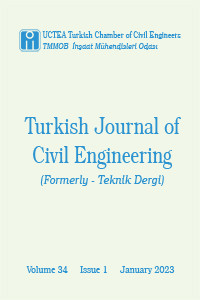Simulation Models for Hydro-Electric Energy by Steady-Rate and Night-Shift-Pumped-Storage Operations
Simulation Models for Hydro-Electric Energy by Steady-Rate and Night-Shift-Pumped-Storage Operations
Reservoir operation, hydro-electric production by daily time steps, pumped-storage hydropower plants renewable energy, water resources,
___
- IHA (2018) The world’s water battery: Pumped hydropower storage and the clean energy transition. International Hydropower Association. www.hydropower.org/publications/
- Zhang S, Andrews-Speed P, Perera P (2015) The evolving policy regime for pumped storage hydroelectricity in China: A key support for low carbon energy. Applied Energy, 150, 15–24. http://dx.doi.org/10.1016/j.apenergy.2015.03.103
- Uria-Martinez R, Johnson M M, Shan R (2021) U.S. Hydropower Market Report. U.S. Department of Energy, Office of Energy Efficiency & Renewable Energy, Water Power Technologies Office, USA. http://www.osti.gov/bridge
- Gimeno-Gutierrez M and Lacal-Arantegui R (2015) Assessment of the European potential for pumped hydropower energy storage based on two existing reservoirs. Renewable Energy, 75, 856–868. http://dx.doi.org/10.1016/j.renene.2014.10.068
- DSI (2022) General Activities Report of the Year 2021 (in Turkish). General Directorate of State Hydraulic Works, Ministry of Forestry and Water Works of Republic of Türkiye, Ankara, Türkiye.
- Ak M, Kentel E, Savasaneril E (2019) Quantifying the Revenue Gain of Operating a Cascade Hydropower Plant System as a Pumped-Storage Hydropower System. Renewable Energy. DOI: 10.1016/j.renene.2019.02.118
- Aydemir A, Acanal N, Haktanir T (2019) Efficient Use of Renewable Energy Sources: Pumped Storage Hydroelectric Power Plants. In E. Hüseyin & A. Nurlan (Eds.), 3rd International GAP Congress on Mathematical-Engineering-Technical-Medical Sciences, Proceedings, 917–923. https://www.gapzirvesi.org/
- Aydemir A and Haktanir T (2019) Integration of Pumped Storage Hydropower Plant to Çamlıgöze Dam. Internationally Participated The 1st Innovation, Sustainability, Technology and Education in Civil Engineering Conference, Proceedings, 640–651. http://iste-ce2019.iste.edu.tr/
- Ayder E (2015) Pumped Storage Hydroelectric Power Plants, Technical Report (by Prof. Dr. Erkan Ayder) (In Turkish) Mechanical Engineering Department, Istanbul Technical University, Istanbul, Türkiye.
- Bozdemir M (2013) Evaluation and Analysis of Pumped-Storage Hydroelectric Plants for Türkiye (In Turkish). M.Sc. Thesis, Bilecik Seyh Edebali University, Graduate School of Sciences, Electrical and Electronics Engineering Program, Bilecik, Türkiye.
- Cicek O and Ozdemir M B (2021) Pumped Storage Hydroelectric Power Plant Design. Gazi Journal of Engineering Sciences, 7(1), 26-35. https://dx.doi.org/10.30855/gmbd.2021.01.04
- EIE (2008) Elektrik İşleri Etüt İdaresi Genel Müdürlüğü İlk Etüt Raporları, 2008 (In Turkish). General Directorate of Electrical Works Planning and Reconnaissance, Ankara, Türkiye. http://www.eie.gov.tr/
- Firis F A, Karadol I, Sekkeli M (2022) Investigation of Unit Commitment Problem in Presence of Pumped Storage Hydroelectric Power Plants: The Case of Kahramanmaras. Gazi Journal of Engineering Sciences, 8(1), 110−121, doi:10.30855/gmbd.2022.01.10
- Haktanir T, Aydemir A, Acanal N (2021) A study on three different hydropower operation rules by monthly and daily time steps. Proceedings of the Institution of Civil Engineers – Energy, 174(1) 24−34. https://doi.org/10.1680/jener.19.00066
- Karacay P (2010) Pumped Storage Power Plants and Their Status in Türkiye (In Turkish). M.Sc. Thesis, Istanbul Technical University, Graduate School of Sciences, Civil Engineering Department, Hydraulics and Water Resources Program, Istanbul, Türkiye.
- Unver U, Bilgin H, Guven A (2015) Pumped-Storage Hydroelectric Systems (In Turkish). Mühendis ve Makina (A national journal in Turkish), 56(663), 57−64.
- Yenerji (2014) The Project of Karakurt Dam and Hydropower Plant Revised Feasibility Report (in Turkish) Yenerji Engineering and Consulting Co., Ankara, Türkiye, www.yenerji.com.tr
- USACE (1985) Engineering and Design HYDROPOWER, EM 1110-2-1701. U.S. Army Corps of Engineers, Washington, DC, 20314-1000.
- Sever S and Yurtal R (2022) Simulation of Multi-Purpose Multi-Reservoir System Operations by HEC-ResSim (In Turkish) Teknik Dergi, Paper 708, 12863-12875.
- Haktanir T, Aydemir A, Acanal N Versions of the drainage area ratio method for transfer of daily or monthly stream flows. Proceedings of the Institution of Civil Engineers – Water Management, https://doi.org/10.1680/jwama.21.00091, ahead of print.
- Openstreet, Openstreet map database 2022, Available under the Open Database Licence from: https://www.openstreetmap.org/copyright, accessed 10.09.2022
- HGM, General Directory of Mapping, Republic of Türkiye, Ministry of National Defense, Türkiye shape file: https://www.harita.gov.tr/urun/turkiye-mulki-idare-sinirlari/232, accessed 10.09.2022
- Haktanir T and Cobaner M (2007) Feasibility of hydropower plant installation to existing irrigation dams. Water International, IWRA, 32(2), 254–264. https://doi.org/10.1080/02508060708692205
- Elliott T C, Chen K, Swanekamp R C (1998) Standard Handbook of Power Plant Engineering, Section 7. Hydroelectric Power Stations, Second Edition. McGraw-Hill, New York.
- Coyne et Bellier (1986) Sir Dam and Hydroelectric Project, Water Potential and Power Studies (Revision). Coyne et Bellier, Bureau d’Ingenieurs Conseils, Paris, France, Aknil Engineers Consultants, Ankara, Cukurova Elektrik A.Ş., Adana, Türkiye.
- Gulliver J S and Arndt R E A (1991) Hydropower Engineering Handbook. McGraw-Hill.
- DSI (2015) Circular 2015/5 Criteria for Reconnaissance and Feasibility Studies (in Turkish). Investigation, Planning and Allocations Department, General Directorate of State Hydraulic Works, Ministry of Forestry and Water Works of Republic of Türkiye, Ankara, Türkiye.
- Hydropower Europe (2019) Hydropower Technologies The State-of-the-Art. Document No. WP4-DIRp-02, Lead author: Emiliano Corà, Contributors: Jean Jacques Fry, Mario Bachhiesl, Anton Schleiss. A technical report prepared under grant agreement No 826010 supported by the European Union's Horizon 2020 research and innovation programme.
- European Clean Energy Alliance (2022) Joint Declaration European Electrolyser Summit V9 public. European Commission, Hydrogen Europe, Advent, Bosch, Convion, Cummins, DeNora, Elogen, Enapter, Genvia, Green Hydrogen Systems, Hydrogen & Energy Systems, H2B2, HyStar, John Cockerill, McPhy, NEL Hydrogen, Siemens Energy, Solid Power, Sunfire, Thyssenkrupp nucera, Topsoe, Brussels, 5 May 2022.
- Minitab: Data Analysis, Statistical & Process Improvement Tools, www.minitab.com Minitab, LLC 1829 Pine Hall Road, State College, PA, USA.
- ISSN: 2822-6836
- Yayın Aralığı: 6
- Başlangıç: 1990
- Yayıncı: TMMOB İnşaat Mühendisleri Odası
Betonarme Perdelerin Kesme Güvenliğinin TBDY-2018’e Göre İncelenmesi
Kuzey Kıbrıs’taki Havzaların Morfometrik Parametreler Kullanılarak Kümelenmesi
Identifying Interrelated Factors of Fatal and Injury Traffic Accidents Using Association Rules
Zeliha Çağla KUYUMCU, Hakan ASLAN, Nilüfer YURTAY
Operational Barriers against the Use of Smart Contracts in Construction Projects
Handan KÜNKCÜ, Kerim KOC, Asli Pelin GURGUN, Houljakbe Houlteurbe DAGOU
Simulation Models for Hydro-Electric Energy by Steady-Rate and Night-Shift-Pumped-Storage Operations
